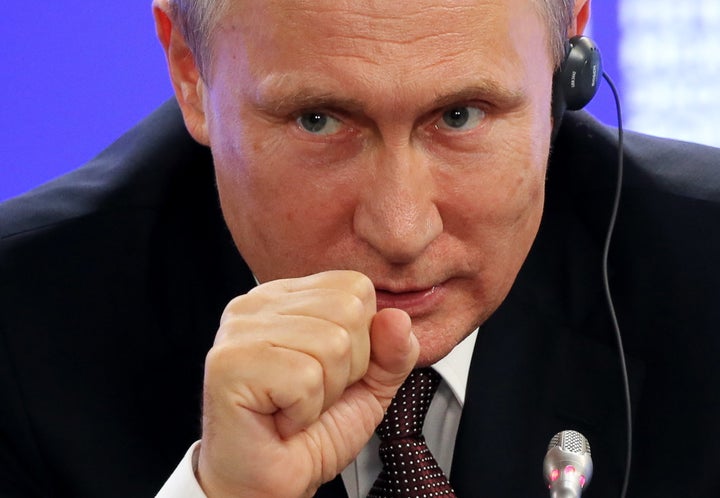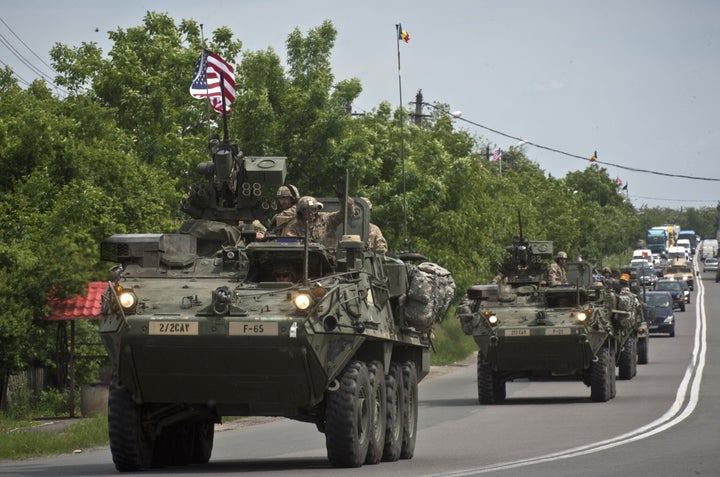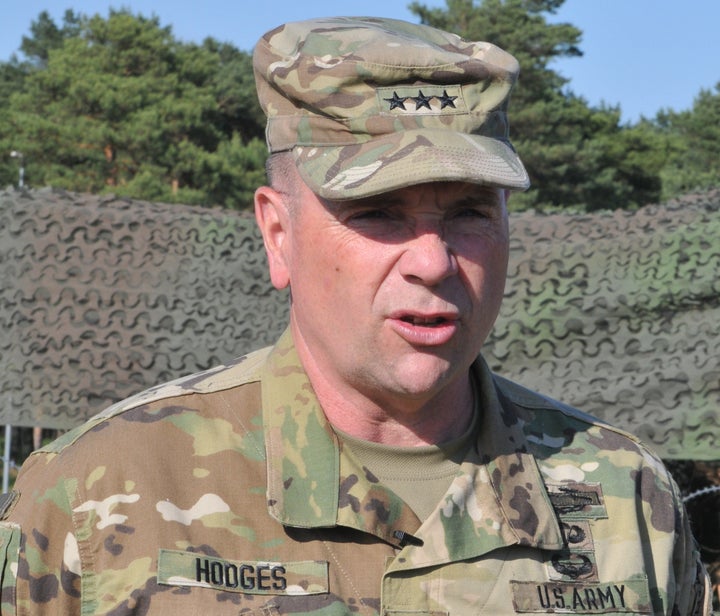
One Monday afternoon in June, several hundred American, British and Polish troops parachuted into central Poland. Last month's jump was just practice, part of an extended NATO rehearsal for a defense of northern Europe against Russia.
But in a real crisis -- if those soldiers were called to defend the Baltic states -- they could be dropping into a death trap.
The mile-long drop zone in north-central Poland was just 180 miles from the major Russian military base at Kaliningrad, well within range of Russian missiles designed to shoot down aircraft like the lumbering C-17s that slowed to drop the paratroopers. Once on the ground, the lightly armed soldiers would likely be targeted by swarms of Russian drones and blasted by long-range Russian artillery, as Ukrainian troops were just last year.
The allied paratroopers were practicing to secure a land corridor and a river crossing so that a column of lightly armored U.S. Stryker vehicles could then race to help defend Lithuania, Latvia and Estonia from Russian incursion. Those Strykers that survived massed artillery and rocket barrages would have to funnel into Lithuania along a 60 mile-wide stretch of the border, squeezed between Belarus, a Russian ally to the south, and the guns of Kaliningrad to the north. It’s known locally as the Suwalki Gap.
In U.S. military terms, a kill zone.
War games like these are increasing in scope and intensity, as NATO’s northern flank is once again a global flash point.
The Western alliance’s Baltic members lie in the shadow of a newly aggressive Russia, rearmed and ready to take advantage. Those three countries were once part of its Cold War empire, and Russian President Vladimir Putin considers them “our historic territory.” But now NATO is committed to come to their aid if summoned. President Barack Obama specifically swore to defend them.
Any clash would raise the risk of unplanned escalation and the implicit threat of nuclear weapons. So shoring up NATO’s border defenses is on the agenda as alliance leaders gather for this week's summit in Warsaw -- along with terrorism, the tidal wave of refugees and Britain’s decision to leave the European Union.
But managing this confrontation with Russia, with its powerful Cold War antecedents, is more than a matter of troop strength. The inevitable disputes will require delicate handling and steady nerves in the Kremlin and the White House. Western leaders, including the next president -- possibly Donald Trump -- will have to find ways to reassure the Baltics without provoking Moscow into a mounting crisis.
A decade ago, it seemed like a low-risk commitment to absorb the Baltic states and other Eastern European nations into NATO with the promise to defend them at any cost. Following the collapse of the Soviet Union in 1991, Russia was struggling with its own political and economic woes. With little direct threat, the United States had withdrawn the bulk of its Cold War military forces from Europe, and most NATO countries had reduced their own defenses.
Then, while the U.S. and NATO were busy in Iraq and Afghanistan, Putin rebuilt his military into a powerful high-tech force. Two years ago, he used it to grab the semi-autonomous region of Crimea. Last year Russian forces seized a chunk of Ukraine in a display of combat power that stunned American generals.
That was “a real wake-up call,” Army Lt. Gen. H.R. McMaster told a congressional committee in April.
McMaster runs the Army’s most elite think tank, the Army Capabilities Integration Center, and he’s leading a crash study of the Russian military threat and how the U.S. should respond. He told Congress that the Russians have the ability to jam and blind U.S. military communications. He said the networks of Russian missiles and artillery could put at risk the aircraft on which the U.S. relies to counter enemy air defenses and jam enemy communications, attack tank formations and support friendly ground troops. Russia’s long-range artillery, he said, is “more lethal” than anything the U.S. can field.
In an extraordinary admission, McMaster told the Senate Armed Services Committee that the United States and its European allies can no longer assume they have superiority in the air, on land or at sea. “What we’ve seen broadly here is that we cannot rely on maintaining dominance in any domain,” he said.
The Pentagon’s top brass were particularly struck by one 2014 incident, described in an account by Phillip Karber and Joshua Thibault for the Potomac Foundation, a Washington area think tank. In July of that year, Russia attacked two Ukrainian tank battalions with long-range artillery and multiple rocket-launchers firing smart top-attack munitions and enormously powerful thermobaric warheads. “This intensely concentrated fire strike lasted only a few minutes,” they reported, “yet inflicted high casualties and destroyed most armored vehicles, rendering both battalions combat-ineffective.”
If Putin ran the same lightning land-snatch in the Baltic states, his forces could smash through NATO defenses and occupy at least two Baltic capitals within 60 hours, according to a series of war games conducted by the Rand Corporation, the nonpartisan defense think tank. That would leave U.S. and European leaders with two bad choices, Rand concluded: Do nothing, effectively ceding parts of NATO to Russia, or escalate into an all-out “bloody counter-offensive” that could lead to the brink of a nuclear exchange.

Already, Putin is accusing NATO of reckless provocation. The Russian president recently signed off on a new military strategy clearly aimed at countering the Western alliance, which he accuses of encroaching on Russian sovereignty and creating “a threat to the national security” to his country.
In a June 22 speech he drew a parallel between the 1941 Nazi invasion of Russia and the recent NATO exercises. “NATO is stepping up its aggressive rhetoric and its aggressive actions close to our borders,” he said. In response, he said Russia was “obliged” to strengthen its defenses, placing three new divisions in the region nearest the Baltics.
The Russian Embassy in Washington did not respond to repeated requests to discuss these issues.
Pushback from Washington has been firm. The White House has proposed tripling the U.S. budget for NATO defense, to $3.4 billion in 2017, which would enable the Army to add a heavy armored brigade and an F-15 tactical fighter squadron in Europe and to beef up special forces and anti-submarine patrols.
“We don’t seek a cold, let alone a hot, war with Russia,” Defense Secretary Ash Carter said on May 3. “We don’t seek to make Russia an enemy. But make no mistake, we will defend our allies.”
Moscow’s actions and rhetoric, he added, raise “troubling questions about Russia’s leaders’ commitments to strategic stability, their respect for norms against the use of nuclear weapons, and whether they respect the profound caution that nuclear-age leaders showed with regard to the brandishing of nuclear weapons.”
Western concern is rising high enough that at this week’s summit, NATO leaders are expected to approve a plan to bolster the alliance’s defenses by stationing a battalion in each of the three Baltic states and one in Poland. That’s four new battalions, roughly 4,000 troops overall.
Russia will likely respond, perhaps by carrying out its old threat to install nuclear-capable short-range Iskander ballistic missiles in Kaliningrad, well within range of the Baltics. Moreover, those additional NATO troops, expected to be drawn from U.S. and European armies, will face at least 22 full-strength Russian battalions across the border.
“That isn’t going to stop a determined Russian advance,” Steven Pifer, a former U.S. ambassador to Ukraine, told HuffPost. “But it would build a pretty robust tripwire. The Russians would have to consider that they’d kill a lot of Americans.”
For anxious countries like Estonia, having an American or European battalion on local soil would be enormously reassuring, underscoring that an attack on their country would bring an armed response from NATO. The message to Russia is that “if you cross that line, you are at war against 28 countries,” said Eerik Marmei, Estonia’s ambassador to Washington.
Still, the clear imbalance of forces disturbs senior combat leaders like Lt. Gen. Ben Hodges. He commands all U.S. Army forces in Europe, and over his career, he has watched the gradual withdrawal of most U.S. forces from the continent.
“When I was a young lieutenant in [Cold War] Germany, we had 300,000 troops and the mission was to deter Russia and reassure the allies,” he told HuffPost. “Now I have 30,000 troops and the mission is to deter Russia and reassure the allies.”
What he’s seen the Russians do in Ukraine over the last few years sharpens his concern. “They have massive amounts of artillery and rockets, cluster munitions. … It’s a very, very lethal battlefield. And there’s a significant increase in electronic warfare, jamming. And dropping drones out of the sky,” he said. “Things are a bit more dangerous.”
Not long ago -- when Hodges was a fresh lieutenant -- the East-West border region was the most heavily armed place on earth, where generals joked that one more tank, one more artillery shell, one more nuclear warhead might cause the whole thing to tilt and slide into the ocean.
Indeed, for centuries, the tectonic plates of empire and alliance have ground against one another here, generating rivalries that regularly erupted in violence. During the past century alone, German, Russian and Austro-Hungarian empires, as well as the Nazi Third Reich, clashed in brutal upheavals that killed millions, smashed nations to pieces and generated animosities that burn to this day.
Since the Cold War sputtered to an end a quarter-century ago, the focus of four American presidents and the U.S. defense establishment has shifted to the turbulent Middle East, Iraq and Afghanistan. They hoped, too, to sustain a cordial relationship with the Kremlin.
Behind Russia’s borders, though, Putin was planning and preparing to reassert its power.
“Russia never went anywhere. We just quit paying attention,” Gen. Mark A. Welsh, the U.S. Air Force chief of staff, remarked at a Council on Foreign Relations conference in May.

Until recently, American and allied military forces were assumed to be easily superior to the Russians, who were weakened by post-Cold War neglect. Exercises like the one that recently brought paratroopers to Poland rarely took place -- they seemed relatively unnecessary.
Now the U.S. military is racing to catch up, dusting off big-war skills it hasn’t used since 9/11.
Artillerymen, who were widely diverted to serve as infantry troops in Iraq and Afghanistan, are back to practicing artillery skills. At the Army training center in the Mojave Desert, battalions have abandoned counterinsurgency training and turned instead to major tank battles and coordinating maneuvers with artillery, airstrikes and electronic warfare.
And after 15 years of war in Iraq and Afghanistan, where there was no threat from the sky, American troops are relearning how to protect themselves from spy drones and attack jets. For the first time in a generation, the paratroopers involved in the recent NATO exercise jumped wearing green-and-black camouflage face paint. Once on the ground, they slung camouflage nets over their positions and practiced “jumping” their command post frequently to avoid detection.
But that won’t be enough, according to the Rand war games, in which senior U.S. military officers and defense officials played the roles of Russian and NATO commanders. In various realistic scenarios, they found that American paratroopers “can put up stout resistance when dug into urban terrain.” But “these forces likely could not be resupplied or relieved before being overwhelmed.”
“By and large,” the Rand study said, “NATO’s infantry found themselves unable even to retreat successfully and were destroyed in place.”
A recent study by the Strategic Studies Institute of the U.S. Army War College came to the same conclusion: NATO, it said, “lacks the capability to defeat a surprise Russian conventional attack into the Baltic States or Eastern Europe.”
Such conclusions were met with skepticism aboard the C-17s that carried the 82nd Airborne paratroopers from Fort Bragg, North Carolina, to Poland.
“Everybody here has read the Rand report,” Maj. Robert Lodewick told HuffPost, dismissing the idea that the division is unprepared.
“Know your enemy, respect your enemy -- but we’re clearly not scared of them,” Col. Anthony G. Judge, the division’s operations officer, said as he prepared to jump into Poland to set up the assault command post.
If the Russians were to block signals from GPS satellites, which provide data for U.S. military navigation and targeting, paratroopers are trained to fight from paper maps. “We can fight digitally,” said Capt. Daniel Oberrender, an intelligence officer. “But we really fight with maps -- we are an analog force.”
To guard against being left electronically blind and mute, the paratroopers carry multiple satellite and FM encrypted communications systems hardened against jamming. “Is it reasonable that they could shut us down? No,” said Lt. Col. Patrick Roddy, commander of the 82nd Airborne’s 1st Battalion, 504th Parachute Infantry Regiment, whose troopers jumped into Poland. “If we get jammed, we quickly go to another system.”
The 82nd Airborne and other units train extensively with the Air Force and the Pentagon’s cyber war agencies, using electronic warfare and strike fighters to take out enemy missile sites and ensure that the C-17s can get safely into contested airspace to deliver the paratroopers and their weapons.
Once they’re on the ground, language and cultural differences can hamper coordination among soldiers from multiple nations as they maneuver in the dark with lethal weapons (using blanks, for this exercise). “If our communication situation isn’t locked down tight, it will all fall apart,” Roddy warned his soldiers before they jumped.

Managing the larger NATO-Russia confrontation presents far greater challenges even in peacetime, let alone during a crisis.
How much should the allies beef up their military defenses at the risk of provoking an unwanted response from the Kremlin? At what point during a period of growing tension does it make sense to reassure the Baltic states by sending in paratroopers? If Russia makes even vague threats to shoot down the incoming C-17s, should Washington go ahead and risk the soldiers’ lives? Or back down? Or threaten to escalate and take out Russia’s anti-aircraft missile sites?
A more likely crisis might begin with the kind of creeping Russian aggression that Moscow will deny and that falls short of the kind of overt attack that would trigger a NATO response. It might look like what happened in Crimea in February 2014, when Kremlin-backed partisans engineered pro-Russian demonstrations and clashed with counter-demonstrators, sparking demands that Putin act to protect the Russian-speaking population. Within a week, Russian special forces, called Spetsnaz, had snuck in to seize key government facilities, and more troops followed.
Defense Secretary Carter has referred to this kind of escalating political intervention, especially Russia’s use of unidentified paramilitary troublemakers, as the “little green men” scenario. (It’s also brilliantly dramatized in the Norwegian series “Occupied.”)
The provocateurs might find willing listeners among the many native Russians living in the Baltics -- over 1 million, according to the final Soviet census in 1989.
Ambassador Marmei noted that roughly a quarter of Estonia’s population is Russian-speaking, although he said they are thoroughly integrated into Estonian society. Still, he acknowledged the difficulty of dealing with low-level Russian intimidation and political meddling that could lead to direct intervention.
“It’s one thing if a tank crosses your border,” he told HuffPost. “But if you have Spetsnaz infiltrating and starting uprisings somewhere, how do you deal with that? Where do you draw the line? When is it Article 5?” he said, referring to the NATO common defense clause.
“There is this gray area that NATO has not been very good in dealing with,” he added. Marmei did not specifically mention the alliance’s fumbling response in Ukraine, but the implication was hard to miss.
Part of Russia’s current strategy, according to the nonprofit Institute for the Study of War, is to continue “a campaign of information warfare against the Baltic States paired with political pressure and military provocation,” such as snap military exercises simulating massive attacks into those countries.
“Right now we see a lot of intimidation by Russia,” Marmei said, including flights by military aircraft along the Baltic Sea corridor. Although that’s a major route for commercial air traffic, he said the Russians often fly with their identifying transponders turned off, making it impossible for air controllers to track them.
“We tell the Russians, ‘Please turn on your transponders.’ But they don’t,” Marmei said. “How do you deal with these situations if the other party doesn’t want to listen?”

